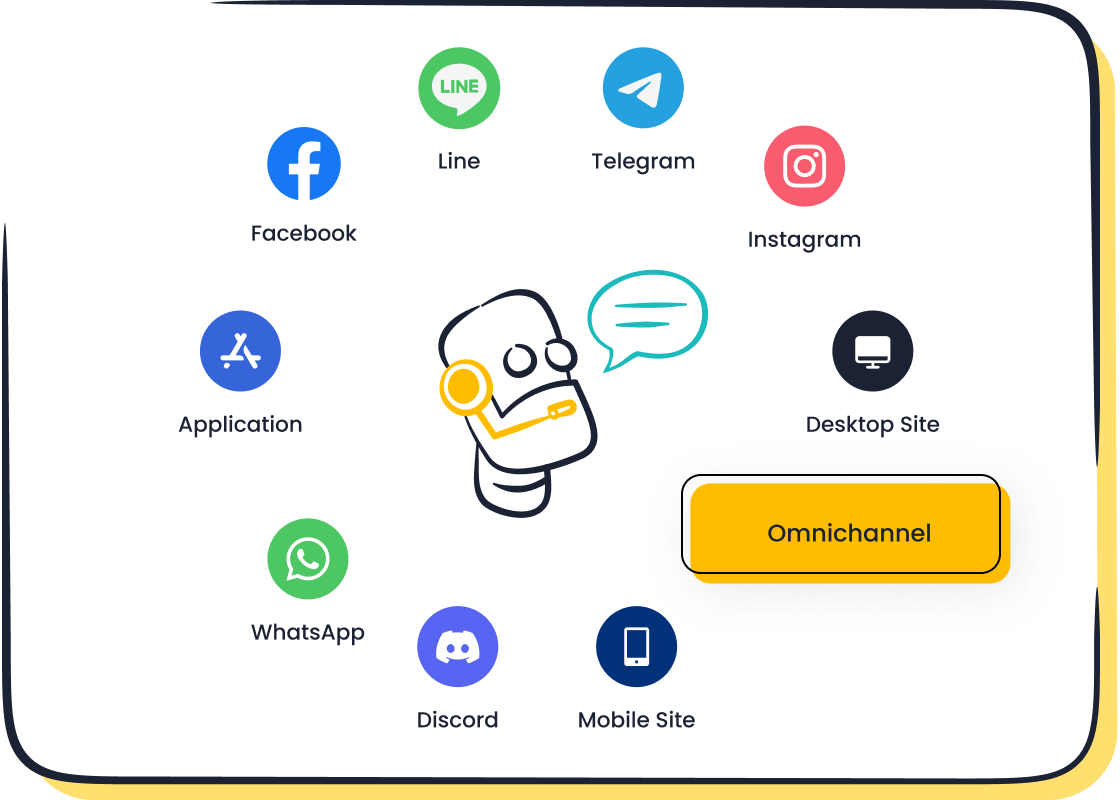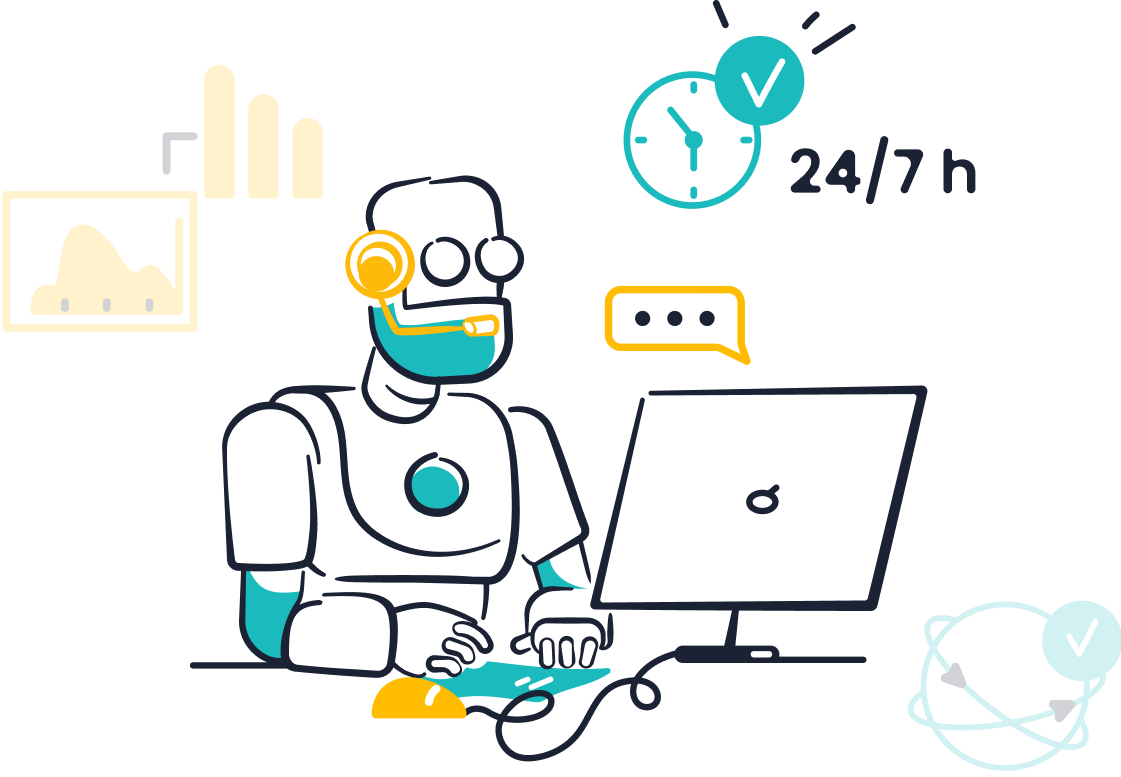Understanding Omnichannel and Multichannel Customer Service

In today’s fast-paced world, customer service plays a vital role in shaping your business success. Omnichannel and multichannel customer service are two approaches that businesses use to enhance the customer experience. Omnichannel customer care ensures a seamless and consistent journey by integrating all communication channels. In contrast, multichannel service operates with separate, independent channels, which can lead to fragmented interactions.
Why does this matter? Studies show that 88% of customers value their experience as much as the product itself. Additionally, businesses with strong omnichannel strategies retain 89% of their customers, compared to just one-third for those with poor integration. Choosing the right approach impacts not only customer satisfaction but also your bottom line. Sobot’s omnichannel solutions, for instance, unify customer interactions, ensuring a smooth and efficient service experience.
What Is Omnichannel Customer Care?

Definition and Core Features
Omnichannel customer care focuses on creating a seamless experience across all communication channels. Unlike multichannel service, which operates independently, omnichannel integrates every touchpoint into a unified system. This approach ensures that you never have to repeat your concerns when switching between channels like email, social media, or live chat.
Customers increasingly expect personalized interactions. Research shows that 71% of customers demand tailored experiences, and 88% believe customer experience is as important as the product itself. Omnichannel customer care meets these expectations by connecting all channels, enabling smooth transitions and consistent service. For businesses, this strategy transforms customer service from a competitive advantage into a standard practice.
How Omnichannel Enhances the Customer Journey
An omnichannel strategy significantly improves the customer journey. It allows you to start a conversation on one platform and continue it seamlessly on another without losing context. This integration reduces frustration and enhances satisfaction. For example, companies with strong omnichannel strategies retain 89% of their customers, compared to just one-third for those with disconnected systems.
The benefits extend beyond retention. Businesses using omnichannel campaigns see a 287% higher purchase rate compared to single-channel campaigns. Additionally, customer retention rates increase by 91% year-over-year, and revenue grows by 9.5% annually. These metrics highlight how omnichannel strategies not only improve your experience but also drive business success.
| Statistic Description | Value |
|---|---|
| Purchase Rate Increase | 287% higher for omnichannel campaigns |
| Customer Retention Rate | 91% greater year-over-year |
| Revenue Increase | 9.5% yearly growth for omnichannel |
Sobot's Omnichannel Contact Center Solution
Sobot’s omnichannel contact center solution exemplifies the power of integration. It unifies customer interactions across platforms like WhatsApp, email, and voice calls, ensuring a smooth and efficient service experience. With features like AI-driven automation and a unified workspace, Sobot helps businesses streamline operations and enhance customer satisfaction.
The solution delivers measurable results. For instance, it reduces inbound discussion volume by 20% and achieves a 95% customer satisfaction rate. Its AI platform provides correct answers 80% of the time, while self-service options resolve 22.2% of questions independently. These capabilities empower you to enjoy faster resolutions and personalized support.

Sobot’s commitment to innovation and efficiency makes it a trusted partner for businesses across industries. By adopting its omnichannel contact center strategy, you can elevate your customer journey and achieve long-term success.
What Is a Multichannel Contact Center?
Definition and Core Features
A multichannel contact center allows you to interact with customers through multiple communication channels, such as email, phone, social media, and live chat. Unlike an omnichannel system, multichannel platforms operate independently, meaning each channel functions as a separate entity. This structure provides flexibility but may lack the seamless integration found in omnichannel systems.
Key features of a multichannel contact center include:
- Agent Multichannel Dashboard: A unified interface for managing all communication channels.
- Multichannel Routing and IVR: Intelligent systems that direct inquiries to the right agent based on skills.
- Call Queueing and Auto Dialer: Tools that enhance productivity by managing call queues and automating outbound calls.
- Better Data and Insights: Aggregated data helps you understand customer behavior and improve strategies.
- Flexibility and Scalability: Easily add or remove channels based on demand.
Research from McKinsey shows that most customers use three to five channels to resolve issues. This highlights the importance of being accessible across multiple platforms to meet customer expectations.
How Multichannel Works in Customer Service
In a multichannel contact center, each channel operates independently. For example, a customer might email your support team and later call for follow-up. However, the two interactions may not connect, requiring the customer to repeat their issue. While this approach offers flexibility, it can sometimes lead to fragmented experiences.
Despite this, multichannel customer service enhances accessibility. Customers can choose their preferred communication method, whether it’s live chat, email, or social media. This flexibility improves engagement and satisfaction. Agents also benefit from tools like multichannel dashboards, which streamline workflows by consolidating tasks into one interface. This setup boosts efficiency and reduces response times.
Examples of Multichannel Applications
Many businesses successfully use multichannel strategies to improve customer service. For instance:
| Company | Multichannel Strategy | Key Takeaways |
|---|---|---|
| Vrbo | Email communication for trip planning and direct communication with hosts. | Engages customers across devices and uses targeted ads to increase retention. |
| CVS | Digital channels replicate in-store experiences, including online chat with pharmacists. | Offers convenience and consistent messaging across platforms. |
| Apple | Combines in-store product demonstrations with online purchasing options. | Builds loyalty through consistent brand messaging and engaging retail experiences. |
| The Home Depot | Integrates digital commerce with in-store expertise, offering DIY resources online. | Provides accessible advice and adapts to customer needs during crises. |
| Under Armour | Uses apps and social media for personalized recommendations and community engagement. | Enhances retention through personalized offers and community building. |
These examples show how multichannel contact centers can cater to diverse customer needs while improving engagement and satisfaction.
Key Differences Between Omnichannel and Multichannel Customer Service
Integration and Consistency
Integration is the cornerstone of omnichannel customer service. It connects all communication channels into a unified system, ensuring seamless cross-channel integration. For example, if you start a conversation on live chat and later switch to email, omnichannel systems retain the context, eliminating the need to repeat information. This consistency enhances your customer journey and reduces frustration.
In contrast, multichannel systems operate independently. Each channel functions as a separate entity, which can lead to fragmented communication. Customers often need to re-explain their issues when switching channels, resulting in inefficiencies. Studies show that omnichannel systems improve operational efficiency by streamlining processes, while multichannel systems may duplicate efforts due to their lack of integration.
| Aspect | Multichannel Fulfillment | Omnichannel Fulfillment |
|---|---|---|
| Channel Integration | Low. Channels operate independently. | High. Seamless integration across all channels. |
| Customer Experience | Inconsistent across channels. | Consistent and unified across touchpoints. |
Customer Experience and Journey
Your customer experience directly impacts satisfaction and loyalty. Omnichannel systems provide a unified experience across all touchpoints. This approach ensures that customers feel valued and understood, as their interactions are consistent and personalized. For instance, businesses with strong omnichannel strategies retain 89% of their customers, compared to just one-third for those using disconnected systems.
Multichannel systems, while offering flexibility, often result in fragmented experiences. Customers may feel disconnected when switching between channels, as the lack of integration disrupts their journey. Omnichannel systems address this by centralizing data collection, enabling you to deliver a cohesive and satisfying customer journey.
Technology and Infrastructure Requirements
Implementing omnichannel customer service requires robust technology and infrastructure. You need systems capable of integrating multiple communication channels, such as live chat, email, and social media, into a single platform. For example, Datamatics achieved a 98% improvement in live chat response times and reduced email turnaround time by 4 hours after adopting an omnichannel strategy.
To succeed, you must prioritize channel integration and train your team to handle the new system effectively. Regulatory compliance, such as data protection laws, also plays a critical role. While the initial investment in technology and training may seem high, the long-term benefits—such as increased efficiency and customer satisfaction—make it worthwhile.
Scalability and Flexibility
Scalability and flexibility are essential for modern customer service systems. Both omnichannel and multichannel approaches offer unique advantages in adapting to growing demands and changing market conditions.
Omnichannel systems excel in scalability by integrating all communication channels into a unified platform. This integration allows businesses to expand their operations without compromising the customer experience. For example, omnichannel strategies enable customers to interact with brands across their preferred channels seamlessly. This adaptability is crucial for enhancing engagement and satisfaction. A survey revealed that half of online retailers in Europe and North America consider omnichannel strategies vital for success. These systems also balance physical and online presence, ensuring businesses can scale efficiently to meet market demands.
Multichannel systems, while operating independently, provide flexibility by allowing businesses to add or remove channels based on customer preferences. This approach ensures accessibility across multiple platforms, such as email, social media, and live chat. For instance, a multichannel contact center can quickly adapt to seasonal spikes in customer inquiries by scaling up specific channels like live chat or phone support. This flexibility helps businesses maintain service quality during peak periods.
- Key Statistics Supporting Scalability and Flexibility:
- 87% of businesses believe omnichannel is crucial for success, yet only 8% have mastered it.
- Omnichannel businesses drive in-store visits for 80% of their customers by offering consistent experiences.
- Omnichannel customers shop 1.7 times more than single-channel users.
Sobot’s omnichannel solution exemplifies scalability and flexibility. It integrates AI-driven automation and a unified workspace, enabling businesses to handle high volumes of customer interactions efficiently. This system supports multiple channels, including WhatsApp, email, and voice, ensuring seamless communication. By adopting Sobot’s solution, businesses can scale their operations while maintaining a consistent and personalized customer experience.
Benefits of Omnichannel and Multichannel Customer Service

Benefits of Omnichannel Customer Care
Omnichannel customer care transforms how you interact with your customers by creating a unified and seamless experience across all communication channels. This approach ensures that your customers can transition between platforms, like email and live chat, without losing context. For example, a customer can start a conversation on WhatsApp and continue it via email without repeating their concerns. This integration reduces frustration and enhances satisfaction.
Businesses with omnichannel strategies see a 91% increase in customer retention year-over-year. Customers value convenience and personalization, and omnichannel systems deliver both. They allow you to provide a personalized experience by centralizing customer interactions, enabling agents to access complete customer histories. This approach not only improves customer engagement but also boosts loyalty and trust.
Sobot’s omnichannel solution exemplifies these benefits. It integrates AI-driven automation and a unified workspace, enabling you to manage customer interactions efficiently. With features like proactive messaging and self-service options, Sobot helps you enhance customer satisfaction while reducing operational costs.
Benefits of Multichannel Contact Centers
Multichannel contact centers offer flexibility by allowing you to interact with customers through their preferred communication channels, such as social media, email, or phone. Each channel operates independently, giving you the freedom to tailor your service to specific platforms. This approach improves accessibility and customer engagement.
For instance, multichannel systems enable you to scale operations easily. During peak seasons, you can focus on high-demand channels like live chat or phone support. This flexibility ensures consistent service levels. Additionally, multichannel systems provide valuable insights into customer behavior, helping you refine your strategies.
A multichannel approach also enhances operational efficiency. Agents can manage multiple channels from a single dashboard, streamlining workflows and reducing response times. Sobot’s multichannel capabilities, such as its intelligent IVR system and email ticketing, demonstrate how you can optimize resources while maintaining high-quality service.
| Benefit | Description |
|---|---|
| Better customer engagement | Interacts with customers through preferred channels, improving accessibility. |
| Improved customer experience | Offers multiple options for outreach, enhancing first-call resolution and satisfaction. |
| Efficient resource allocation | Optimizes channel-specific skills and enables dynamic workload distribution. |
| Enhanced scalability | Allows scaling of channels based on demand, ensuring consistent service levels. |
Comparing the Advantages of Both Approaches
Omnichannel and multichannel strategies each offer unique advantages. Omnichannel systems excel in creating a unified customer experience. They allow customers to transition seamlessly between channels, enhancing satisfaction and loyalty. For example, customers can abandon their cart on one platform and complete the purchase on another without disruption. This level of integration fosters trust and drives sales.
In contrast, multichannel systems prioritize flexibility. They let you focus on specific communication channels based on customer preferences or operational needs. While this approach may lack the seamless integration of omnichannel systems, it provides the scalability and adaptability required for dynamic customer service environments.
Choosing the right strategy depends on your business goals. If you aim to deliver a personalized experience and improve customer retention, omnichannel is the way to go. However, if you need flexibility and scalability, a multichannel approach might be more suitable. Sobot’s solutions cater to both strategies, ensuring you can meet your customers’ needs effectively.
Challenges in Implementing Omnichannel and Multichannel Strategies
Common Challenges in Omnichannel Implementation
Implementing an omnichannel strategy can be complex. One of the biggest challenges is data integration and management. You need to consolidate large volumes of customer data from various sources while ensuring accuracy and compliance. Legacy systems often make this process difficult. Additionally, outdated technology can hinder your ability to track customer behavior across channels effectively.
Another challenge is maintaining a consistent customer experience. Without defined links between channels, customers may face inconsistencies that harm their perception of your brand. Measuring performance across channels also becomes difficult when marketing efforts are siloed. This lack of integration complicates optimization and reduces efficiency.
| Challenge | Description |
|---|---|
| Data integration and management | Handling large volumes of data from multiple sources, especially with legacy systems. |
| Inadequate technology | Outdated systems that fail to track customer behavior effectively. |
| Customer experience inconsistencies | Lack of channel links leading to fragmented experiences. |
| Measuring performance difficulties | Siloed efforts making it hard to optimize customer experiences. |
To overcome these challenges, you must invest in robust technology and train your team to deliver seamless, personalized service.
Common Challenges in Multichannel Implementation
Multichannel strategies also come with their own set of hurdles. Choosing the right technology partner is critical but often challenging. You need a system that can manage multiple channels effectively. Training your team to handle cross-channel interactions is another significant task. Without proper training, agents may struggle to provide consistent support.
Inconsistent customer experiences often arise due to weak integration between channels. This fragmentation can dilute your brand voice and frustrate customers. Measuring performance becomes difficult when marketing efforts are not aligned. Inefficient resource allocation is another issue, as independent channel operations can lead to duplicated efforts.
- Key challenges in multichannel implementation:
- Selecting the right technology partner.
- Training agents for cross-channel interactions.
- Maintaining a unified brand voice.
- Measuring performance across siloed channels.
- Allocating resources efficiently.
Addressing these challenges requires a clear strategy and tools that streamline operations.

Overcoming These Challenges with Sobot's Chatbot
Sobot’s AI-powered chatbot offers a practical solution to these challenges. It operates 24/7, handling repetitive queries and reducing inbound inquiries by 20%. This allows your team to focus on complex issues. The chatbot provides correct answers 80% of the time and achieves a 95% customer satisfaction rate, ensuring consistent and reliable support.
| Metric | Value |
|---|---|
| Reduction in inbound inquiries | 20% |
| Customer satisfaction feedback | 96%+ |
| Correct answers provided | 80% |
| Problems solved | 85% |
The chatbot integrates seamlessly with omnichannel systems, ensuring smooth transitions between platforms. Its multilingual capabilities and no-coding-required setup make it accessible for businesses of all sizes. By adopting Sobot’s chatbot, you can overcome the challenges of both omnichannel and multichannel strategies while enhancing customer satisfaction.
How to Choose the Right Strategy for Your Business
Assessing Your Business Needs and Goals
Choosing between an omnichannel or multichannel strategy starts with understanding your business needs. Identify your primary goals. Are you aiming to improve customer retention, enhance satisfaction, or reduce operational costs? For example, if your focus is on delivering a seamless customer experience across all platforms, an omnichannel strategy may align better with your objectives. It integrates communication channels, ensuring consistency and personalization.
On the other hand, if your business prioritizes flexibility and scalability, a multichannel strategy might be more suitable. This approach allows you to manage each channel independently, adapting to specific customer demands. For instance, during peak seasons, you can scale up live chat or phone support to handle increased inquiries. By aligning your strategy with your goals, you can create a customer service system that drives success.
Evaluating Your Customer Base and Preferences
Understanding your customer base is crucial. Analyze their preferences, behaviors, and communication habits. Do they prefer interacting through social media, email, or live chat? Omnichannel platforms provide valuable insights into customer behavior, helping you identify trends and preferences. These tools also allow you to personalize marketing efforts and adjust your customer service approach.
For example, if your customers frequently switch between channels, such as starting a conversation on WhatsApp and continuing it via email, an omnichannel strategy ensures a smooth transition. However, if your customers tend to stick to one channel, a multichannel strategy may suffice. By evaluating your customer base, you can tailor your approach to meet their expectations and enhance satisfaction.
Considering Budget and Resources
Your budget and resources play a significant role in determining the right strategy. Implementing an omnichannel system often requires a higher initial investment due to the need for advanced technology and integration. However, the long-term benefits, such as increased efficiency and customer loyalty, can outweigh the costs.
A multichannel strategy, while more cost-effective initially, may require additional resources to manage independent channels. For small businesses with limited budgets, this approach can provide a practical solution. Sobot’s solutions cater to both strategies, offering scalable and efficient tools that fit various budgets. By assessing your financial capacity and resource availability, you can choose a strategy that aligns with your business goals.
Aligning with Long-Term Business Strategy
Your customer service approach should align with your long-term business strategy to ensure sustainable growth. This alignment helps you meet evolving customer expectations while achieving your organizational goals. For example, if your business aims to expand globally, adopting an omnichannel system can provide the scalability and consistency needed to serve diverse markets effectively.
A well-aligned strategy also ensures that your customer service investments deliver measurable results. Businesses with clear alignment between their service approach and long-term goals report a 20% higher customer satisfaction rate, according to a study by Deloitte. This alignment allows you to prioritize resources, focus on high-impact areas, and adapt to market changes without compromising service quality.
Sobot’s solutions are designed to support your long-term objectives. For instance, its omnichannel platform integrates AI-driven automation and a unified workspace, enabling you to scale operations while maintaining a seamless customer experience. Whether your goal is to improve customer retention, reduce costs, or enhance operational efficiency, Sobot’s tools provide the flexibility and reliability you need.
Consider your future plans when choosing between omnichannel and multichannel systems. If you anticipate rapid growth, an omnichannel approach offers the integration and scalability required to handle increasing customer interactions. On the other hand, a multichannel system may suit businesses focusing on flexibility and cost management. By aligning your customer service approach with your long-term strategy, you can build a foundation for lasting success.
Tip: Regularly review your customer service performance to ensure it continues to align with your business goals. Tools like Sobot’s analytics can provide valuable insights to guide your adjustments.
Understanding the differences between omnichannel and multichannel customer service helps you choose the right approach for your business. Omnichannel systems provide seamless integration across platforms, enhancing customer satisfaction and loyalty. Multichannel systems offer flexibility by allowing you to manage each channel independently. Both strategies have unique benefits, but aligning your choice with your business goals ensures success.
Evaluate your current customer service approach. Identify areas for improvement and consider tools like Sobot’s solutions to enhance efficiency. By focusing on customer needs and expectations, you can create a service experience that drives satisfaction and long-term growth.
FAQ
What is the main difference between omnichannel and multichannel customer service?
Omnichannel integrates all communication channels into one system, ensuring a seamless experience. Multichannel operates each channel independently, offering flexibility but lacking integration. For example, omnichannel allows a conversation to move from email to live chat without losing context, while multichannel may require repeating information.
How does Sobot’s omnichannel solution improve customer satisfaction?
Sobot’s omnichannel solution unifies interactions across platforms like WhatsApp and email. It uses AI-driven automation to resolve 22.2% of inquiries independently and achieves a 95% satisfaction rate. This ensures faster resolutions and personalized support, enhancing the overall customer experience.
Can small businesses benefit from omnichannel systems?
Yes, small businesses can benefit greatly. Omnichannel systems improve efficiency by centralizing data and automating repetitive tasks. Sobot’s solutions, for instance, are scalable and cost-effective, making them suitable for businesses of all sizes aiming to enhance customer interactions.
What are the challenges of implementing multichannel customer service?
Challenges include managing independent channels, training agents for cross-channel interactions, and maintaining a unified brand voice. Sobot’s tools, like its intelligent IVR system and email ticketing, simplify these tasks by streamlining workflows and improving efficiency.
How do I decide between omnichannel and multichannel strategies?
Assess your business goals and customer preferences. If you prioritize seamless experiences and retention, choose omnichannel. If flexibility and scalability are key, opt for multichannel. Sobot’s solutions cater to both, ensuring you can meet your specific needs effectively.
See Also
Navigating Omnichannel Solutions for Effective Call Centers
A Comprehensive Guide to Deploying Omnichannel Contact Centers
Excelling in Live Chat for Retail Businesses